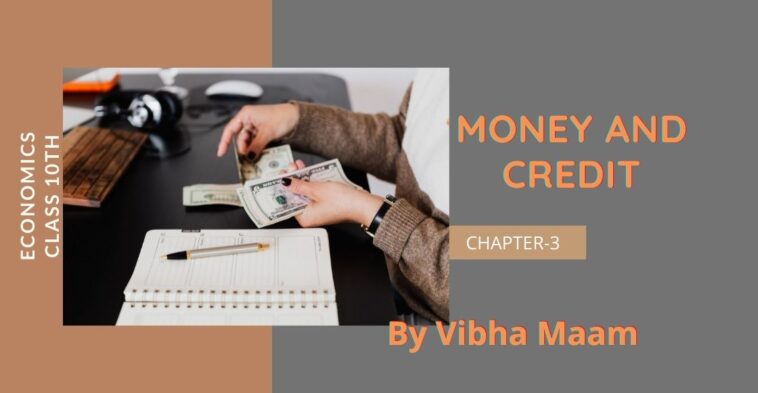Checkout handpicked notes of NCERT class 10th Economics Chapter 3 Money and Credit notes by Vibha Madam and don’t forget to share your valuable comments in the comment below to motivate our author.
Money and Credit Notes by Vibha Maam
Money as a medium of exchange
Money
Anything can be money which has common acceptability as the means of exchange and measure and store of value.
Money can easily exchange for any commodity or service. Money eliminates the need for double coincidence of wants.
Money acts as an intermediate in the exchange process.
Different phases of Medium of Exchange
Ancient phase- Barter system, where goods are directly exchanged with other goods but ‘double coincidence of wants’ is the essential feature of this system. Grains and cattle were used as money before the introduction of coins.
Mediaeval phase- Use of metallic coins like gold, silver, copper etc.
Modern phase- Use of currency like paper notes and plastic money. it is accepted as a medium of exchange because it is authorized by the government of India.
Limitations of Barter system
- Lack of double coincidence of wants
- Lack of store of value
- Lack of standard for deferred payments
- Lack of a common unit of value
Modern forms of Money
Paper notes and coins, plastic money and deposits with banks like cheque, demand draft, demand deposit, money order.
Loan activities of bank
- In India, the Reserve Bank of India (RBI) issues currency notes on the behalf of the central government.
- People deposit their surplus money in the bank by opening a bank account in their name.
- Banks accept the deposit and also pay an amount as interest on the deposits.
Depositors can withdraw their money whenever they require. Therefore these deposits are called ‘demand deposits’.
A cheque is a paper, instructing the Bank to pay a specific amount from the person’s account to the person in whose name the cheque has been issued.
- Out of total money deposited with the bank, the bank keeps 15% of it as cash for paying depositors on demand.
- The rest of the deposited money the bank used to extend loans.
- The banks charge a high rate of interest from the borrowers and pay less rate of interest to the depositors and this difference of interest is the source of income of the bank.
Credit
Credit ( Loan) is an agreement between the lender and the borrower in which the borrower promises to pay the landers in the future.
Two different Credit Situation
- In one situation credit plays a positive role when the borrower is able to complete their necessities and make some profit with the use of this money.
- Sometimes credit is very painful as it pushes the borrower into such a situation from which recovery is very difficult, that is commonly known as debt trap .
Terms of credit
- Collateral (security):- asset of borrower like land, house, vehicle, livestock etc.
- Documentation
- Tenure (time)
- Mode of repayment
- Rate of interest
- Guarantor
People take credit from different sources which can be grouped into two :
- Former sector and
- Informal sector loans.
Formal sector credit in India
RBI supervises the functioning of formal sectors of loans. It also monitors the banks in maintaining cash balance. These sources offer cheap and affordable credit with common terms of credit for all and they charge less interest rate.
Informal sector credit in India
This credit is provided by traders, moneylenders, employers, relatives, friends, etc. There is no organisation for supervision of credit activities. The interest rate of informal loans is much higher than the formal sectors. terms of credit are flexible.
Self-Help Groups (SHGs) for the poor
- This is a new idea to organise rural poor, particularly women and pool their savings.
- Generally this group has 15 to 20 members.
- Savings per member varies from Rs25 to Rs100 or more.
- They get a loan from the bank even though they have no collateral.
- Small loans are provided to the members by this group.
- SHGs help women in making them financially self-reliant.
Don’t forget to comment in the comment section below to appreciate and motivate our author by sharing this notes with your friends you can also Contact us for any query or if you are interested in writing with us.
Use Canva for amazing images.
Stay tuned for more amazing stories, poems & articles like this.
For sponsor any article or your article you can mail us with your logo ready and details.











thanks maam for providing points to points notes